
I still remember the day I first delved into the world of search engine optimization (SEO). It was a sunny afternoon, and I was sipping coffee at my favorite café, flipping through a book on digital marketing. The concept of SEO fascinated me—the idea that one could optimize content to appear higher in search engine results was both intriguing and empowering. Little did I know that artificial intelligence (AI) and machine learning (ML) would soon revolutionize this field, reshaping the strategies we'd come to rely on.
Introduction
Definition of AI/ML
Overview of Impact on SEO
Relevance
Google’s Determination of Topic and Relevance
The Evolution of SEO in the Age of AI and ML
Understanding AI and ML
Before we dive deeper, let's take a moment to understand what AI and ML truly are. Artificial intelligence is a branch of computer science that aims to create machines capable of intelligent behavior. It's about developing systems that can perform tasks that usually require human intelligence, such as recognizing speech or making decisions. On the other hand, machine learning is a subset of AI focused on the idea that machines can learn from data, identify patterns, and make decisions with minimal human intervention.
The Impact on SEO Strategies
When I started working on SEO, the focus was primarily on keywords and backlinks. We'd stuff articles with keywords, sometimes to the point of redundancy, just to rank higher. However, with the advent of AI and ML, this approach became obsolete. Search engines became smarter, understanding not just the presence of keywords but the context and relevance of content. It was like the game rules changed overnight.
Relevance: The New King in SEO
Google's Advanced Algorithms
Google, the giant that it is, has always been at the forefront of utilizing AI and ML. With algorithms like BERT (Bidirectional Encoder Representations from Transformers) and MUM (Multitask Unified Model), Google's search engine can now comprehend the natural language more effectively than ever before.
For instance, if someone searches for "best ways to optimize supply chain management process tips," Google doesn't just look for pages with matching keywords. Instead, it understands the intent behind the query and provides results that offer practical tips and strategies on optimizing supply chain management. This shift emphasizes the importance of creating content that is not only keyword-rich but also contextually relevant and valuable to the reader.
Personal Experiences with Relevance
I recall working with a client who ran an e-commerce business. Despite having quality products, their website wasn't ranking well. Upon analyzing, we realized their content was outdated, filled with keyword stuffing, and lacked genuine value. We revamped their content strategy, focusing on providing insightful articles that addressed their customers' pain points. We included stories, tips, and even underlined key points for emphasis.
Within months, their website's ranking improved significantly. This experience taught me that relevance is indeed the new king in SEO, and understanding AI's role in determining this relevance is crucial.
The Drawbacks of AI and ML in SEO
Inherent Human Biases
Despite the advancements, AI and ML are not without flaws. One of the major concerns is the inherent human biases that these technologies can carry. Since AI models are trained on data created by humans, any existing biases in the data can be learned and propagated by the AI.
For example, if an AI model is trained predominantly on data from a specific demographic, it might not accurately represent or serve content relevant to other groups. This bias can affect which websites are deemed relevant, potentially skewing SEO results unfairly.
Vulnerability to Disinformation
Another significant issue is the vulnerability to disinformation. AI and ML can sometimes be manipulated by organized disinformation campaigns, leading to the spread of false information. This not only affects the credibility of search engines but also poses a challenge for SEO professionals aiming to promote genuine content.
I once encountered a situation where a client's reputable content was overshadowed by misleading articles that had been strategically optimized using AI. It was a frustrating experience, highlighting how AI can sometimes be a double-edged sword in the world of SEO.
The Demand for Computing Resources
Moreover, generating and maintaining AI models requires substantial computing resources. For small businesses or individual SEO professionals, accessing the necessary technology can be a barrier. The costs associated with high-performance computing and data storage can be prohibitive, making it challenging to compete with larger entities that have the resources to leverage advanced AI models.
Potential Solutions to Mitigate Drawbacks
Embracing Diverse Datasets
One effective way to address inherent biases is by using diverse datasets when training AI models. By ensuring that the data encompasses a wide range of perspectives and demographics, we can create AI systems that are more equitable and accurate in determining relevance.
In the AI/ML Age, SEO must be used responsibly to ensure relevance, avoid bias, and combat disinformation.

Promoting Transparency and Accountability
Transparency in how AI algorithms function can build trust and allow for better oversight. By understanding how decisions are made, SEO professionals can adapt their strategies accordingly. Holding organizations accountable for the outcomes of their AI systems is also crucial in promoting fairness.
Leveraging Human Oversight
While AI and ML are powerful, human oversight remains essential. Humans can identify nuances and contextual factors that machines might miss. By combining AI's efficiency with human judgment, we can create a more balanced approach to SEO.
Utilizing Cloud Computing
To overcome the hurdle of computing resources, cloud computing offers scalable solutions. Cloud platforms provide access to powerful computing capabilities without the need for significant upfront investment in infrastructure. This accessibility democratizes the use of AI and ML in SEO, allowing more professionals to benefit from these technologies.
Practical Tips for SEO Professionals
Staying Updated with AI Developments
In this ever-evolving landscape, staying informed about the latest AI advancements is crucial. Reading industry publications, attending workshops, and participating in professional networks can keep you ahead of the curve.
Creating Quality, Relevant Content
Focus on producing content that genuinely adds value to your audience. Understand their needs, answer their questions, and provide insights that they can't find elsewhere. Remember, relevance and quality trump quantity and keyword density in the AI age.
Ethical SEO Practices
Adopt ethical practices that consider the implications of AI and ML. This includes being mindful of biases, avoiding manipulative tactics, and prioritizing the user's best interests.
Optimizing Supply Chain Management Processes
Interestingly, the principles of SEO in the AI era can be applied to other fields, such as supply chain management. By leveraging AI to analyze data and predict trends, businesses can optimize their processes. Here are some tips:
1- Integrate AI for Demand Forecasting: Use AI algorithms to predict customer demand accurately.
2- Enhance Inventory Management: Implement ML models to optimize stock levels and reduce waste.
3- Streamline Logistics: Utilize AI for route optimization to improve delivery efficiency.
4- Improve Supplier Relationships: Analyze supplier performance data to make informed decisions.
5- Embrace Automation: Automate repetitive tasks to increase efficiency and reduce errors.
These strategies can lead to significant improvements, much like how AI enhances SEO practices.
Conclusion
Reflecting on the Journey
Looking back, it's incredible to see how far we've come since that sunny afternoon at the café. The integration of AI and ML into SEO has transformed the field, making it more dynamic and challenging. It's no longer just about being seen; it's about being relevant, authentic, and ethical.
The Road Ahead
There's no doubt that AI and ML will continue to shape the future of SEO. While challenges exist, especially concerning biases and disinformation, solutions are within our reach. By combining technological advancements with human insight and ethical considerations, we can navigate this new landscape successfully.
References
Russell, S., & Norvig, P. (2020). Artificial Intelligence: A Modern Approach (4th ed.). Pearson.
Bücker, H., Hegland, M., Périaux, J., & Wesseling, P. (Eds.). (2008). Advances in High Performance Computing. Springer.
Goodfellow, I., Bengio, Y., & Courville, A. (2016). Deep Learning. MIT Press.
Croft, W. B., Metzler, D., & Strohman, T. (2015). Search Engines: Information Retrieval in Practice. Addison-Wesley.
Liao, S. M. (Ed.). (2020). Ethics of Artificial Intelligence. Oxford University Press.
Note: The above references are included to provide further reading on the topics discussed and are integral to the content of this article.
Key Takeaways
AI and ML have significantly altered SEO practices, focusing more on relevance and user intent.
There are drawbacks, including biases and susceptibility to disinformation, which need addressing.
Solutions include using diverse datasets, transparency, human oversight, and cloud computing.
Ethical practices and staying informed are essential for SEO professionals in the AI era.
Principles from AI-enhanced SEO can be applied to optimize supply chain management processes, offering valuable tips for efficiency.
By embracing these insights, we can not only improve our SEO strategies but also contribute positively to the broader digital landscape. After all, at the heart of it, we're all striving to connect, inform, and engage in meaningful ways.
Frequently Asked Questions
How can SEO professionals ensure that their content is relevant to Google's AI/ML algorithms?
Search Engine Optimization (SEO) professionals have long been aware of the importance of creating relevant content for their target audiences. However, as search engines continue to develop Artificial Intelligence (AI) and Machine Learning (ML) algorithms to match content with user intent better, SEO professionals must also ensure that their content is up-to-date with these algorithms. Here, we discuss tips SEO professionals can use to ensure their content is relevant to Google's AI/ML algorithms.
Firstly, SEO professionals should ensure that their content is relevant to the user's search query. This includes using the appropriate keywords in the content and providing information that is useful and relevant to the user. Additionally, content should be structured in a way that is easy for the search engine to index and written in a way that is easy to read and understand.
Secondly, SEO professionals should use schema markup to make their content more relevant to search engine algorithms. Schema markup provides additional information about the content that helps the search algorithm to understand it better. This additional information can include things such as the type of content, the topics covered, or the author of the content.
Thirdly, SEO professionals should ensure that their content is up-to-date with the latest trends. By keeping up with the latest trends, SEO professionals can ensure that their content is more relevant to the current search algorithm. This can include minor changes such as adding new keywords or changing the structure of the content.
Finally, SEO professionals should use analytics to track the performance of their content. This will allow them to identify areas where the content is not performing as well as it should and make changes accordingly. Additionally, analytics can help SEO professionals identify how the algorithm responds to their content and act accordingly.
In conclusion, SEO professionals must ensure that their content is relevant to Google's AI/ML algorithms. Following the tips outlined in this article, SEO professionals can ensure that their content is up-to-date and optimized for search engine algorithms. This, in turn, can help to improve their content's visibility in search engine results and drive more organic traffic to their websites.

What strategies can be employed to mitigate the potential for bias and disinformation in AI/ML-driven SEO?
The advent of artificial intelligence (AI) and machine learning (ML) technologies have revolutionized the way search engine optimization (SEO) is conducted. AI/ML-driven SEO is becoming increasingly crucial in optimizing content for search engine results, as it can process large quantities of data and make predictions more efficiently than traditional SEO techniques. However, with the greater reliance on AI/ML-driven SEO, there is increased potential for bias and disinformation to be introduced. To ensure that AI/ML-driven SEO can provide accurate and reliable search results, several strategies can be employed to mitigate the potential for bias and disinformation.
One important strategy is to ensure that the data used to train the AI/ML-driven SEO model is balanced and unbiased. This includes using data not skewed in favor of any particular viewpoint or world view. The data should be collected from various sources and randomly sampled to ensure that the model is not learning from skewed data. Additionally, it is essential to ensure that any collected data is up-to-date and accurate.
Another strategy for mitigating the potential for bias and disinformation in AI/ML-driven SEO is ensuring that the algorithms used to process the data are transparent and easily understood. This includes providing a clear explanation of the algorithms used and making sure that the algorithms are not biased in any way. Additionally, it is essential to make sure that the algorithms are regularly tested and updated to ensure that they can accurately process the data and provide reliable results.
Finally, it is essential to ensure that the AI/ML-driven SEO algorithms are regularly monitored and audited to provide accurate and reliable results. This includes regularly checking the algorithms against a set of known results to detect any discrepancies or errors in the results being provided. Additionally, it is essential to ensure that potential biases or disinformation are identified and addressed as soon as they are detected.
By employing these strategies, it is possible to reduce the potential for bias and disinformation in AI/ML-driven SEO. By collecting balanced and unbiased data and ensuring that the algorithms used are transparent and regularly monitored, and audited, it is possible to ensure that AI/ML-driven SEO can provide accurate and reliable results.

How can SEO professionals leverage programmatic solutions and human oversight to optimize their content for AI/ML-driven search engines?
In recent years, Artificial Intelligence (AI) and Machine Learning (ML) have become increasingly important to SEO professionals as search engine algorithms become more complex and sophisticated. As search engines continue to evolve and use AI/ML-driven technology to provide users with more accurate and meaningful results, SEO professionals must stay abreast of these changes to remain competitive. This article will discuss how SEO professionals can leverage programmatic solutions and human oversight to optimize their content for AI/ML-driven search engines.
SEO professionals can optimize their content for AI/ML-driven search engines by using programmatic solutions. Programmatic solutions provide data-driven insights that can inform content decisions and optimize website structure and content for better performance on search engine results pages (SERPs). By leveraging programmatic solutions, SEO professionals can gain valuable insights into the current search engine algorithms and the user intent behind specific search queries. This data can then inform content decisions and optimize existing content to ensure it is up-to-date and relevant to the user intent.
In addition to programmatic solutions, SEO professionals can leverage human oversight to optimize their content for AI/ML-driven search engines. While programmatic solutions can provide data-driven insights and help optimize content, human management is still necessary to ensure the content provides users value. For example, human oversight can include manual keyword research to ensure the content is optimized for the correct search terms and manual review of the content to ensure it is up-to-date and accurate. Additionally, human oversight can help identify potential improvement opportunities, such as adding additional content or restructuring the content for better performance on SERPs.
In conclusion, SEO professionals must stay abreast of the latest developments in AI/ML-driven search engines to remain competitive. Leveraging programmatic solutions and human oversight can help SEO professionals optimize their content for better performance on SERPs and provide users with more relevant and meaningful results. By combining programmatic solutions and human oversight, SEO professionals can ensure their content is up-to-date and optimized for SERPs' best performance.
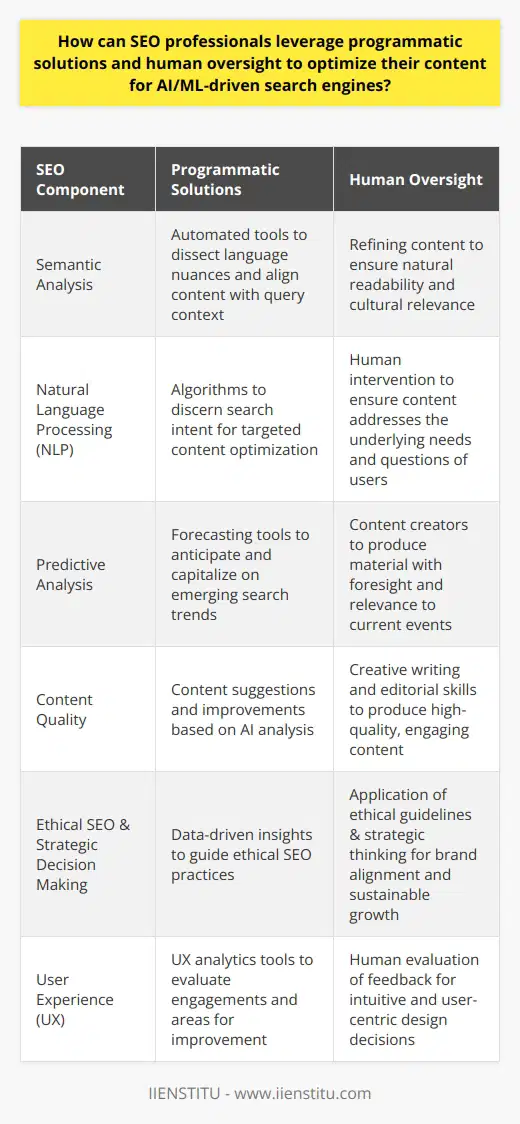
What is the role of artificial intelligence in enhancing SEO strategies?
Role of Artificial Intelligence in SEO
Understanding User Intent
The primary role of artificial intelligence (AI) in enhancing SEO strategies is to better understand user intent. By studying user behavior and search patterns, AI algorithms predict and deliver more relevant content, improving overall search experiences for users.
Content Optimization
Next, AI tools help in creating and optimizing website content. Automated processes analyze keywords, enhance readability, and ensure content is valuable and informative, enabling site owners to optimize web pages based on AI insights.
Semantic Analysis
Another critical role of AI is semantic analysis, which involves identifying the context and meanings behind user queries. By discovering relationships and connections between words, AI systems can help SEO strategists target more pertinent keywords and phrases for their content.
Personalized User Experience
Moreover, AI can deliver personalized user experiences based on individual preferences and browsing habits. By employing machine learning algorithms, AI can identify and present content tailored to the user's interests, increasing the likelihood of interaction and engagement.
Link Building
AI-powered tools also facilitate link building strategies, helping digital marketers identify high-quality link prospects, assess their viability, and automate outreach. This efficient approach to link building can significantly impact SEO rankings and domain authority while saving time and resources.
Data Analysis
Lastly, AI enables a more efficient analysis of data and performance metrics tracking. SEO professionals can leverage AI to gather insights more quickly, identify trends or weaknesses, and adjust strategies to maximize success.
In conclusion, from understanding user intent and optimizing content to personalizing user experiences and enhancing link building, AI plays a pivotal role in enhancing SEO strategies. As AI technology continues to improve, the integration of AI-driven processes with traditional SEO methods will likely become an essential component for businesses aiming to optimize their online presence and remain competitive in the digital landscape.
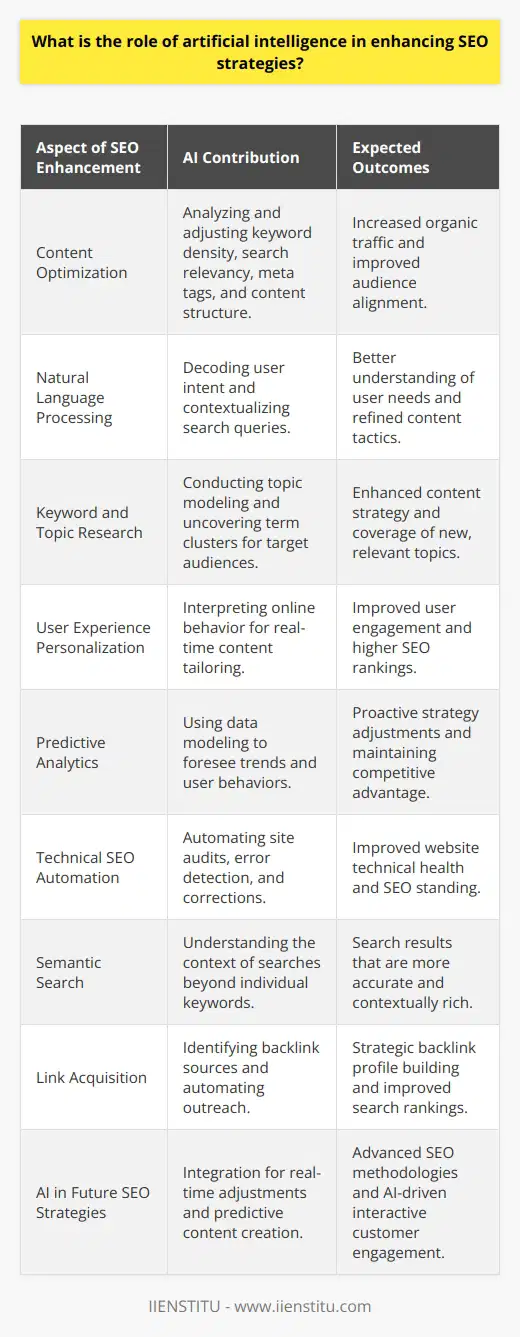
How can AI-powered tools help in identifying and addressing biases in digital content?
**Identification of Biases**
AI-powered tools can play a significant role in identifying biases present in digital content. With the ability to analyze vast volumes of data at an unprecedented speed, these tools can review digital content and detect any possible biases. Algorithms that use natural language processing (NLP), a subfield of AI concerned with understanding human language, can discern patterns in text that indicate biases. By leveraging machine learning, the tools can recognize and learn from biased language instances, improving their ability to identify biases over time.
**Addressing Biases in Content**
When biases are detected, AI-driven tools can suggest revisions and adjustments to content creators. By providing automated feedback, content creators receive tangible recommendations to edit and improve their content. These edits can be aimed at reducing the prevalence of biased language or stereotypes in digital content or ensuring a more balanced representation of different groups. Additionally, AI-powered tools can support content creators in avoiding clickbait headlines or shareable quotes containing biased perspectives, further mitigating the spread of biased information.
**Enhancing Diversity and Inclusion**
Implementing AI-powered tools can also foster an inclusive and diverse digital environment. By detecting and addressing biases proactively, content creators can eliminate potential barriers for marginalized groups. This ensures that content reaches a broader audience, avoids perpetuating stereotypes, and promotes diverse viewpoints. Consequently, these efforts contribute to the larger goal of eradicating systemic prejudices and creating a digital landscape that represents the richness and diversity of society.
**Continuous Improvement**
The use of AI in identifying and addressing biases in digital content is an iterative process. As these AI models learn from more data sources and receive feedback from users, their capabilities in detecting biases are enhanced. This continuous improvement means that AI-driven tools will become more accurate and effective in mitigating biases over time. The ongoing refinement of these tools serves as an essential component in the fight against biases and the promotion of inclusivity in the digital realm.
In conclusion, AI-powered tools are crucial in identifying and addressing biases in digital content. By analyzing language patterns, providing feedback for improvement, enhancing diversity and inclusion, and continuously improving their accuracy, these tools offer a robust solution in mitigating biases and creating an inclusive digital environment.
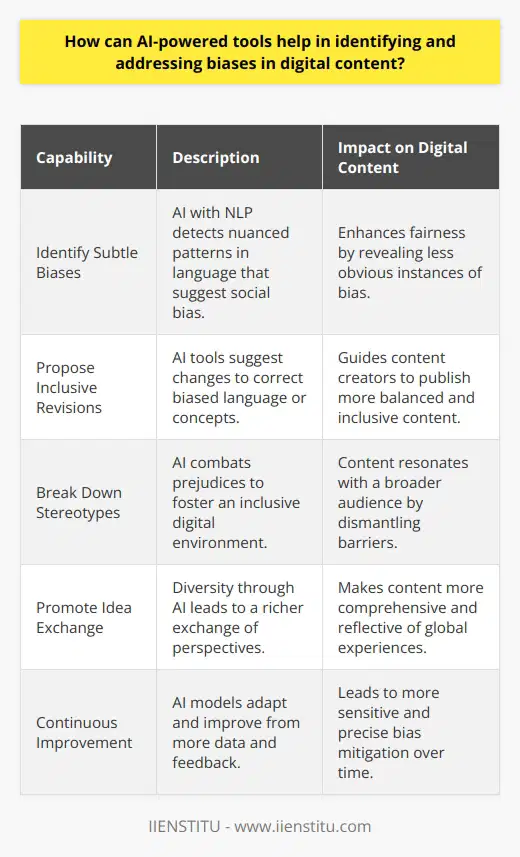
In what ways do AI algorithms potentially perpetuate biased perspectives in search engine results?
Impact of AI Algorithms on Search Bias
Deep learning and data-driven algorithms are increasingly being integrated into search engines to provide improved user experiences. However, the algorithms behind these applications rely on large datasets for training, which inadvertently introduce several potential issues concerning algorithmic biases.
Origin of Biases in Training Data
One significant aspect in which AI algorithms perpetuate biased perspectives in search engine results is through utilizing biased training data. The sources of such biases include historically discriminatory practices, as well as the underrepresentation or overrepresentation of certain demographics in the data collection process. As a result, search algorithms tend to inherit and reinforce these biases when ranking or presenting search results.
Impact on Search Results
The impact of these biases is reflected in the search results displayed to users. Biased search results lead to a partial representation of the topic, favoring some perspectives while marginalizing or even excluding others. Consequently, this may restrict users from accessing a diverse range of information and perspectives on any given query, propagating existing preconceptions or stereotypes.
Negative Effects on Users
Moreover, these biased search outcomes may have profound societal implications. They could potentially reinforce stereotypes and contribute to marginalization and discrimination against certain groups. As users rely more on search engines for information, they may be influenced by these reinforced biases, subsequently forming or strengthening unconscious biases in their own perspectives.
Efforts to Address Bias in AI Algorithms
To mitigate the potential perpetuation of biased perspectives in search engine results, researchers and developers in the field of AI are continually striving to identify and rectify algorithmic biases. Developing algorithms that promote fairness and remain sensitive to different dimensions of diversity is pivotal in achieving unbiased search results. Additionally, embracing a broader spectrum of data sources while increasing transparency in how such data is collected, processed, and used is essential to counteract AI-induced biases.
In conclusion, AI-driven search engines possess the potential to perpetuate biased perspectives due to limitations in learning from biased training datasets. This has profound implications on search results, user experiences, and society at large. Addressing these biases through fairness-aware algorithms and increased transparency in data usage is crucial to fostering a just and unbiased digital space.

What is the role of AI in combating keyword stuffing and other manipulative SEO techniques?
Role of AI in Identifying Keyword Stuffing
AI plays a crucial role in detecting and combating manipulative SEO techniques, particularly keyword stuffing. Through natural language processing (NLP) algorithms, AI systems can analyze the content of websites, identify the repetitive use of targeted keywords, and discern instances of keyword spamming.
Uncovering Black Hat SEO Techniques
Machine learning models within AI systems can identify patterns of manipulative SEO practices, commonly known as black hat SEO techniques. These tactics include cloaking, link manipulation, and hidden content. AI can assess a website's backlink profile, detect unnatural links, and determine whether these techniques are being employed.
Removing Duplicate Content
Duplicate content is another common manipulation technique, where website creators use copied content to boost SEO rankings. AI systems can effectively identify duplicated content by running text similarity analysis. This helps search engines like Google to identify and demote blogs that violate webmaster guidelines.
Evaluating Content Quality with Language Models
AI can also assess the quality of blog content, ensuring that the website optimizes for user experience rather than merely focusing on keyword density. Advanced AI-powered language models can assign a quality score to content, factoring in aspects such as relevance, originality, and clarity of the writing. This score helps determine the overall ranking of a blog post.
Addressing Link-Farming Methods
AI plays a significant role in fighting link-farming methods, wherein websites collaborate to increase backlinks and elevate search rankings. Machine learning algorithms can analyze an excessive number of backlinks, determine their authenticity, and penalize websites involved in such practices.
Ensuring Ethical Advertising Practices
Finally, AI assists in maintaining ethical advertising practices, ensuring that native advertisements and sponsored content are disclosed appropriately. AI systems can identify undisclosed sponsored content, enabling search engines to penalize blogs involved in misleading their visitors.
Conclusion
Overall, AI is a powerful tool in combating keyword stuffing and other manipulative SEO techniques. By analyzing content quality, detecting black hat SEO practices, and maintaining ethical advertising norms, AI systems ensure a fair and meaningful ranking system guided by the principles of relevance and user experience.

How do AI-driven search engines differentiate between high-quality content and clickbait or spam?
Identifying Quality in AI-Driven Search Engines
Search Engine Algorithms
To effectively differentiate between high-quality content and clickbait or spam, AI-driven search engines employ sophisticated algorithms. These algorithms analyze various elements of a webpage, such as user engagement metrics, relevance, and authoritativeness, to determine its quality and rank it accordingly in search results.
User Engagement Metrics
User engagement metrics play a crucial role in distinguishing quality content from inferior webpages. Search engines track factors such as click-through rates, time spent on a page, and bounce rates to assess the value and popularity of a webpage. High-quality content results in higher user engagement, which translates into improved rankings in search engine results.
Relevance to Search Queries
In addition to user engagement metrics, AI-driven search engines evaluate how relevant a piece of content is to a particular search query. By analyzing the presence and distribution of keywords, search algorithms determine if a webpage accurately addresses the user's query, and thus, justify its ranking. Content that appears to be manipulative or overly optimized for keywords may be flagged as spam and ranked lower on search results.
Authoritativeness and Trustworthiness
Establishing the credibility of a webpage is essential in determining its overall quality. Search engines evaluate factors such as backlink profiles, domain age, and the reputation of the author to gauge the site's trustworthiness and authority within its niche. High-quality content from reliable and credible sources is more likely to be rewarded with a higher rank in search results.
Utilizing Machine Learning Techniques
AI-driven search engines are increasingly relying on machine learning techniques, such as natural language processing, to better understand the meaning and context behind queries and content. By recognizing patterns and correlating them to high-quality content, these search engines are better able to filter out clickbait and spam.
In conclusion, AI-driven search engines utilize a combination of user engagement metrics, relevance analysis, and credibility assessment, along with machine learning techniques, to effectively distinguish between high-quality content and low-quality webpages such as clickbait and spam. This helps ensure that users are consistently presented with valuable, trustworthy content when using search engines.

Can ethical AI algorithms help ensure a fair and balanced representation of diverse perspectives in search engine results?
The Role of Ethical AI in Search Engine Representation
Ethical AI algorithms have the potential to ensure a fair and balanced representation of diverse perspectives in search engine results. These algorithms are designed with the objective of minimizing biases, promoting inclusivity, and addressing fairness concerns in the processing and presentation of information.
Mitigating Cognitive Biases
A primary challenge faced by conventional search engines is the reinforcement of cognitive biases. These biases originate from both the designers of these systems and the users who interact with them. Ethical AI algorithms can be structured to recognize and mitigate potential cognitive biases, thereby enhancing the representation of diverse perspectives.
Promoting Inclusivity
Inclusivity is a key aspect of ethical AI. By incorporating principles of fairness and equity in their design, AI algorithms can foster a more inclusive digital environment. This is achieved through the active consideration of user preferences, cultural contexts, and linguistic diversity in search engine results - elements that traditional search engines may overlook due to commercial interests or design limitations.
Addressing Fairness Concerns
To ensure a balanced representation, ethical AI algorithms must address fairness concerns relating to data. This includes scrutinizing the sources of data, evaluating the quality and relevance of the information, and refining the algorithm's criteria to ensure that underrepresented perspectives and marginalized groups are not further marginalized in the digital space.
Monitoring and Accountability
The development and implementation of ethical AI algorithms necessitate continuous monitoring and accountability. This can be achieved through the collaborative effort of AI developers, policymakers, and relevant stakeholders who work together to assess and refine the algorithms regularly. This process enables more transparent and responsible governance of AI systems, which in turn promotes fairer representation in search engine results.
In conclusion, ethical AI algorithms can help ensure a fair and balanced representation of diverse perspectives in search engine results by mitigating cognitive biases, promoting inclusivity, addressing fairness concerns, and implementing effective monitoring and accountability measures. The adoption of ethical AI principles has the potential to transform the digital ecosystem, making it more equitable and democratic for all users.
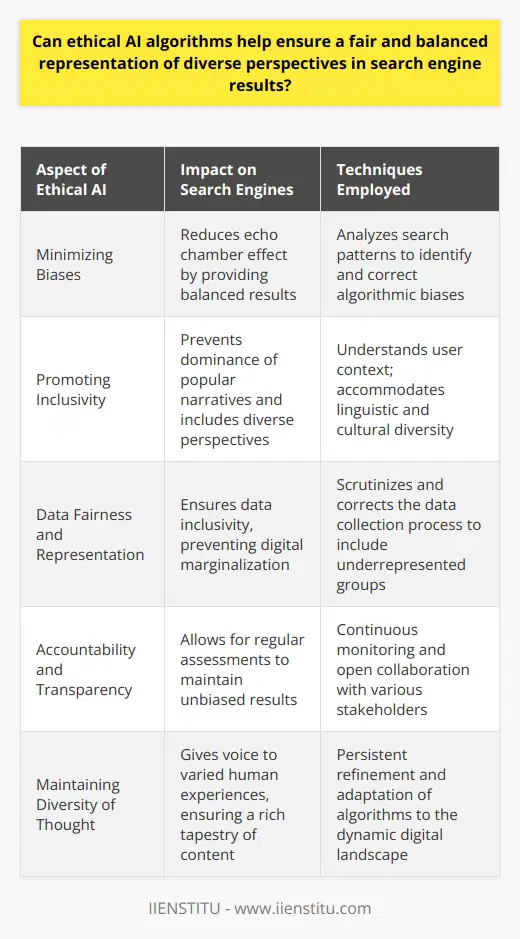
How will SEO be impacted by AI?
AI's Impact on SEO
Innovations in AI
Artificial intelligence (AI) has revolutionized various industries, and the field of search engine optimization (SEO) is no exception. As AI algorithms and technologies continuously evolve, they lead to substantial changes in the way search engines assess and rank content, prompting SEO strategies to adapt accordingly.
Leveraging User Intent
One significant way AI impacts SEO is through the understanding and interpretation of user intent. Search engines deploy AI to analyze context, semantics, and other factors, allowing them to comprehend a query's purpose and deliver more accurate search results. Consequently, SEO professionals must focus on generating content that aligns with the users' needs and utilizes natural language, instead of just concentrating on keywords.
Personalized User Experience
AI-powered search engines have become highly proficient at delivering a tailored user experience based on individuals' preferences, search history, and online behavior. As a result, SEO practitioners must consider these variables and optimize their content to cater to users with varied interests, preferences, and intents, thereby striking an ideal balance between personalization and relevance.
Voice and Visual Searches
With AI advancements, search engines now accommodate voice and visual searches, leading to a more diversified landscape in searching for information. Consequently, SEO professionals must refine their strategies to accommodate these changes, such as optimizing content for voice search by implementing long-tail keywords and conversational phrases, and visual searches by incorporating image and video metadata.
Improved Content Evaluation
As AI algorithms become more sophisticated, their ability to assess content quality has drastically increased. These algorithms can now effectively distinguish between well-researched high-quality content and inferior, poorly written material, heavily influencing their rankings. Therefore, to maintain high search engine visibility, SEO experts must prioritize producing well-structured, relevant, and engaging content audiences find valuable.
Conclusion
In summary, AI is reshaping the SEO landscape through a deeper understanding of user intent, personalized user experience, and enhanced content assessment capabilities. As search engines become smarter and more intuitive, SEO professionals must adapt and refine their strategies accordingly, focusing on creating user-centric, high-quality content that caters to various search preferences and keeps abreast of AI innovations to maintain market competitiveness.

What is the main source of bias within AI and where does bias in AI usually come from?
Main Source of AI Bias
The primary source of bias within artificial intelligence (AI) systems stems from the training data that these systems rely on to learn and make decisions. AI algorithms are essentially data-driven and automatically adjust their performance based on exposure to large quantities of data, primarily through machine learning techniques.
Data Collection and Representation
Bias in AI usually arises during data collection and representation phases. The data used for training AI algorithms may be biased in itself, as it contains human-generated content that inherently exhibits various biases. For instance, if the data samples are primarily from a specific geographic location, the AI system may not perform adequately for users from a different location.
Discriminatory Bias and Underrepresentation
Another reason for bias in AI is the discriminatory bias present in the data. Discriminatory bias occurs when certain groups are underrepresented in the training samples, leading to inadequate representation of these groups within AI algorithms. This can result in unfair outcomes and further exacerbate the underrepresentation or discrimination faced by marginalized groups.
Preprocessing and Feature Selection
Bias can also originate during preprocessing and feature selection steps, where human input may inadvertently introduce subjective preferences or beliefs that can influence the AI system's decision-making process. There might be instances where humans decide to include or exclude certain variables based on their perceived importance, which can lead to biased AI outcomes.
Algorithmic Complexity and Explainability
Lastly, the inherent complexity of AI algorithms can also contribute to biased results, as it becomes challenging to ensure that these algorithms are fair, transparent, and explainable. When the underlying mechanisms of an AI system are too complex for human understanding, it becomes challenging to identify and correct bias in the algorithm.
In conclusion, AI systems are vulnerable to bias due to various factors, including biased training data, underrepresentation of certain groups, human intervention in preprocessing and feature selection, and the complex nature of algorithmic models. To ensure fair and ethical AI systems, it is crucial to employ strategies designed to identify and address possible sources of bias throughout the AI development process.

What are the four types of bias in machine learning and what are the biases created by AI?
### Types of Bias in Machine Learning
To begin with, the four types of bias in machine learning include sample bias, measurement bias, label bias, and overfitting.
### Sample Bias
Sample bias occurs when the training data is unrepresentative of the entire population. This can lead to biased predictions and ultimately affect the overall performance of the machine learning algorithm.
### Measurement Bias
Measurement bias happens when there are systemic errors in the data collection process. These errors can be due to faulty or incomplete measurements of features, leading to inaccurate model predictions.
### Label Bias
Label bias arises when the labels assigned to instances in the dataset are incorrect or biased. The incorrect labels may be due to human error or inherently biased labeling processes, which may lead to misclassifications by the algorithm.
### Overfitting
Lastly, overfitting is the result of a model learning the noise in the data rather than the underlying patterns. Overfit models may perform well on the training data but poorly on unseen data. This can lead to biased predictions and undermine the model's generalizability.
### Biases Created by AI
Artificial intelligence algorithms inherit biases from their training data, which often reflect existing societal biases. One such example is gender and racial biases present in natural language processing models, stemming from biased training data. This can result in biased machine translation outputs or an unfair representation of certain social groups.
Another instance of AI-created bias is in the use of facial recognition technology. Biased training datasets can lead to the misidentification and discrimination of individuals, particularly those belonging to minority groups.
Moreover, AI systems may reinforce existing biases when they are applied to decision-making processes, such as in hiring or lending. Biases present in historical decisions can be perpetuated by the AI system, potentially exacerbating inequalities and reinforcing discriminatory practices.
In conclusion, understanding and addressing the various types of bias in machine learning is crucial to ensuring fairness and accuracy in AI-driven tools and applications. By actively working to mitigate these biases, we can create more inclusive and equitable AI systems that better serve all of society.

What is SEO in artificial intelligence?
SEO in Artificial Intelligence Context
The term SEO denotes Search Engine Optimization. This digital method aims to enhance the visibility and ranking of specific websites on search engine results pages (SERPs).
Understanding AI and SEO
AI, meaning artificial intelligence, plays a compelling part in SEO now. Algorithms systematically perfect search results using machine learning techniques. Google's algorithm known as RankBrain, for example, employs machine learning to evaluate and rank websites.
AI’s Role in SEO
AI significantly aids SEO tasks. By automating extensive processes like keyword research and optimization, it saves marketers time and builds efficiency. AI applies data from user behavior to assist content creation, curating material that engages audiences better.
AI SEO Tools
Numerous SEO tools powered by AI exist today. They provide insights into competitors' activities, deliver personalized experiences, and predict future trends. These tools streamline processes, producing better results in less time.
AI’s Impact on SEO Strategy
Crucially, AI has the potential to change SEO strategy. AI algorithms are becoming increasingly focused on user intent rather than exact-match keywords. This means SEO tactics must adapt to factor in semantic search, prioritizing context and relevancy.
In conclusion, SEO and AI go hand in hand in modern digital marketing. AI is altering SEO approaches, making them increasingly intuitive and automated. However, AI's influence on SEO is a developing area, with new opportunities and challenges arising continually.

How is artificial intelligence affecting SEO?
Understanding AI Influence on SEO
Artificial intelligence (AI) plays a key role in transforming Search Engine Optimization (SEO). AI-enhanced algorithms like Google's RankBrain help to interpret user queries more effectively.
Improved User Query Interpretation
This interpretation process focuses on the intention behind search phrases. This intent-based search improves the accuracy of search engine results. It directly impacts SEO strategies required for higher page ranking.
Role of Machine Learning
AI uses machine learning to analyze user behavior. Machine learning applications review search trends and predict future behaviors. These factors contribute to changing SEO tactics to accommodate evolving user preferences.
Semantic Search Enhancement
Furthermore, AI aids in semantic search enhancement. Semantic search understands the context and nuances of search phrases. SEO strategists must adapt by focusing on relevance and contextual understanding over keyword density.
Automation and Data Analysis
AI technology allows for automation in data analysis. By analyzing vast amounts of data quickly, AI can identify effective SEO strategies. It spotlights backlink opportunities and keyword performance, paving the way for improved SEO efforts.
Voice Search Optimization
Finally, AI has catalyzed the rise of voice search. Hence, SEO strategies now prioritize conversational keywords and long-tail phrases.
In conclusion, AI significantly affects SEO by optimizing user intent understanding, refining semantic searches, automating data analysis, and facilitating voice search. As AI continues to evolve, so too will the methods and strategies employed by SEO practitioners.
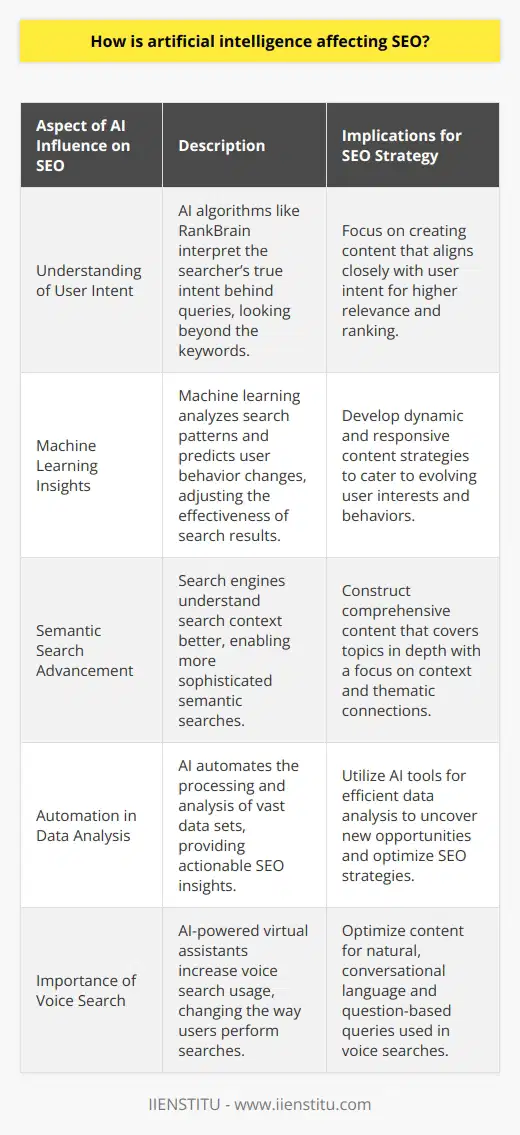
Is AI biased or unbiased?
Understanding AI Bias
Bias in artificial intelligence (AI) emerges from human involvement. Data scientists design AI systems and train these systems using data. If bias exists in this design or data, the AI system will also possess this bias.
Data Influence on AI Bias
All AI systems learn from data to predict and classify information. If training data reflects a biased human behavior, then the AI system will induce the same bias. For example, if a company's data shows preference towards hiring males, the AI system would predict a male as the preferred hire.
Role of Human Intervention
AI just follows instructions given by humans. If a programmer intentionally or unintentionally codes discriminatory standards into an AI system, the corresponding results realize bias. An AI system without human bias is only a theoretical concept, as human involvement is integral to AI development.
The Ambiguity of 'Unbiased'
Skepticism exists around the label 'unbiased' for AI systems. The definition of 'unbiased' can be elusive. It depends on a person's perspective, and these perspectives often differ. Hence, what one perceives as unbiased might be biased to another person.
Mitigating AI Bias
Steps can be taken to mitigate AI bias. Developers should use diverse data sets for training. Inclusion of ethics in AI development is critical. Regular monitoring and auditing of AI systems can help identify and reduce any bias.
In conclusion, AI systems do not inherently bring bias. Instead, they mirror the biases found in their development process. This mirrors the biases of the developers or in the data they use to train. Addressing this bias is crucial in producing equitable AI systems.



